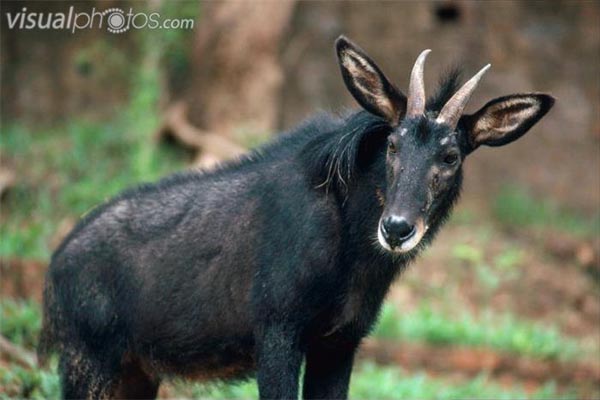MAINLAND SEROW
Capricornis (or Nemorhaedus) sumatraensis
Physical Description
The Mainland, or Asiatic, Serow is one of the three species of serows. Serows are the most generalized representatives of the bovid subfamily of goat antelopes called Caprinae, all of which probably evolved from a serow-like ancestor. The Mainland Serow’s coarse, somewhat long fur is coloured reddish chestnut to black.
Most Mainland serows also have a white or pale yellow neck patch and several lighter-coloured patches on their limbs. The Mainland Serow has a short beard, and a thick mane that extends down the length of its back from the back of its neck to its tail.
The Mainland Serow has short, conical horns that are ridged at the base and slope backwards. The horns of female serows are shorter than the horns of males, which measure, at most, 28 centimetres (11 inches) in length. The Mainland Serow’s narrow, pointed, mule-like ears are usually longer than its horns.
The Serow has a short body and long legs. The length of the Serow’s body is 140 to 180 centimetres (55 to 71 inches) and the length of the Serow’s tail is 8 to 16 centimetres (3.1 to 6.3 inches). The Serow stands about a meter (3.3 feet) tall at the shoulder, and weighs from 85 and 140 kilograms (187 to 309 pounds).
Habitat
The Mainland Serow inhabits forests and wooded gorges in the mountains, at elevations from 2,000 to 3,330 metres (6,000 to 10,000 feet), as well as grassland and shrubland, at lower altitudes. The Serow’s habitat range extends north from the Himalayas of Nepal to China’s Gansu and Anhui provinces, and across South East Asia, as far south as the Malay Peninsula and Sumatra.
Eating Habits
The Serow is a ruminant. As is the case with other ungulates, or hoofed mammals, the Serow cannot manipulate food with its forelimbs. Instead, the Serow’s lips, teeth, and tongue are modified to take food directly from a plant and to grind vegetation like a mill. The Serow is a selective browser, eating grasses, herbs, and the leaves, shoots, and twigs of trees and shrubs.
Behaviour and Reproduction
The Serow is most active at dawn and dusk. During the heat of the day, the Serow takes shelter among the rocks, in caves, under overhanging rocks or cliffs, or in dense underbrush. The Serow is not as agile as the Goral, nor does it move as quickly, but the Serow is sure-footed, clambering easily along well-defined trails on mountain slopes. Furthermore, the Serow’s smell, vision, and hearing are acute. The Serow is also a good swimmer.
The Serow is usually solitary, especially the male; however, serows are sometimes found in pairs or family groups consisting of up to seven individuals. A solitary serow’s territory may measure only about 12,000 square metres (three acres) in area, while the territory of a family group may measure up to 220,000 square metres (54 acres) in area. Serows mark their territories by rubbing a secretion from their preorbital glands on rocks.
The Serow mates in late autumn. The gestation period of the Serow is about 200 to 230 days. Serow mothers give birth in the summer, each to a single kid weighing about 3.6 kilograms (8 pounds). The Serow kid reaches full size and leaves its mother’s territory one year after birth. The Serow reaches sexual maturity at approximately three years old. The Serow’s life span in the wild is unknown, but Serow in zoos have lived for over 10 years. The Serow’s natural predators include bears, tigers, and wolves. The Serow may use its horns to defend itself.
Present Status
The Mainland Serow is categorized as Vulnerable in the 2003 IUCN Red List of Threatened Species and is listed under Appendix I of CITES. The Serow is under second class protection in China and is included in Schedule II, Part I of the Indian Wild Life (Protection) Act of 1972.
Threats to Survival
The main threat to the Serow’s survival is habitat loss. The Serow’s habitat has been lost as a result of logging and the conversion of forest into cropland and pastureland. The Serow is also hunted, for food, as game, and to obtain its body parts for sale. The Serow’s body parts are used in traditional medicine; serow oil supposedly has bone and joint healing properties. Additionally, the Serow is sometimes trapped in snares set for other animals.
References
America Zoo, Mainland serow, http://www.americazoo.com/goto/index/mammals/415.htm, Aug 2004.
Caprinae Specialist Group, 1996: Capricornis sumatraensis, In: IUCN, 2003: 2003 IUCN Red List of Threatened Species, http://
www.redlist.org, Aug 2004.
PBS, The Living Edens: Bhutan – Animal Archive – Serow, http://www.pbs.org/edens/bhutan/a_serow.htm, Aug 2004.
Thai Society for the Conservation of Wild Animals, Thai Wildlife: Rare or Extinct: Serow, http://www.tscwa.org/wildlife/
rare_or_extinct_08.html, Aug 2004.
Woodland Park Zoo, Animal Fact Sheets, http://www.zoo.org/educate/fact_sheets/serow/serow.htm, Aug 2004.
By: Environment and Development Desk, DIIR, CTA.



comment 0